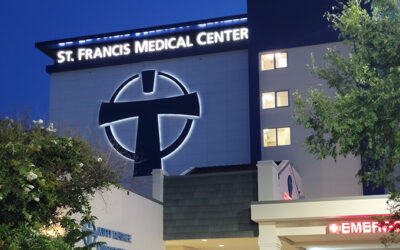On an early morning in September, Daryl Marx, MD, prepared to walk into the operating room at Our Lady of the Lake Regional Medical Center as he has done for years, getting ready to begin another surgery. But this morning was different.
Balloons, congratulatory hugs from colleagues and even a gold crown awaited him to mark a professional milestone: This procedure marked his 5,000th robotic surgery. For Dr. Marx, though, the moment felt surprisingly ordinary.
“It feels like really another day at the workshop, really,” he says with a smile. “I’m happy to be able to continue taking care of patients and doing what I do best.”
That sense of steady purpose has guided Dr. Marx through more than a decade of pioneering work in robotic surgery — a career that has now placed him among an elite few in the country.
He recently became the sixth general surgeon in the country to complete 5,000 robotic operations. Yet he sees the number less as a finish line and more as a reflection of the journey — the countless hours, the colleagues, the lessons learned and the patients who put their trust in him.
Looking back, he says the accomplishment has reminded him of how many people helped him along the way — the nurses and surgical techs who worked beside him, the administrators who believed in robotic technology before it was mainstream, and the patients who said yes to something new.
“Those are the things, in retrospect, that have been most impactful,” he says.
A Mind Built for Mechanics
Even as a child, Dr. Marx was fascinated by how things worked. He had what he calls a mechanical mind — the kind that loves to tinker, to take things apart, to understand every moving part of a machine. Surgery, he realized early on, was simply another version of that same curiosity.
He approached the human body the way an engineer might study an intricate engine: methodically, with a drive to master both the system and the solution. That mindset made robotic surgery a natural fit.
“Surgery gave me the ability to manipulate the function of the machine and, in our situation, repair it,” he says. “So it fit well with my thought process.”
The technology allowed him to use his precision and problem-solving instincts in ways that helped patients heal with less pain and faster recovery.
That natural inclination toward problem-solving led him to embrace robotic surgery early in his career. In 2012, he performed his first robotic procedure — a gallbladder removal that drew local TV cameras and plenty of nerves.
The event made local headlines — the first robotic operation ever performed in Northeast Louisiana. Cameras lined the hallway outside the OR, and a crowd of excited hospital staff and reporters waited for the outcome. Inside, Dr. Marx was focused on the task at hand: removing a patient’s gallbladder.
“The energy was great, but it was still an operation” he recalls. “The intensity of doing this for somebody was there. But it was a great day and very impactful overall.”
That experience cemented his belief that robotic technology wasn’t just a passing innovation — it was the future of surgery.
Building a New Standard
Dr. Marx’s career unfolded alongside the evolution of robotic technology itself. His first system, a da Vinci SiE®, had only three robotic arms and limited capabilities compared to today’s models. Still, he and his team believed in its potential.
At a small hospital in Monroe, he helped lead one of Louisiana’s first robotic surgery programs. Later, he brought his experience to a larger system in Shreveport before joining FMOL Health | Our Lady of the Lake in early 2023.
Recruited by his longtime friend, general surgeon Dr. Jimmy Craven, Dr. Marx was tasked with helping expand the hospital’s robotic surgery footprint. Today, the health system’s hospitals across Louisiana and Mississippi are equipped with the newest da Vinci 5® models, representing the latest leap in surgical precision. For Dr. Marx, the change is almost hard to fathom.
“The technology is so much better,” he says. “It’s 4K, high-definition, 3D. It’s like having two of me in the room working at all times.”
What Robotics Means for Patients
While the sophistication of the machines might impress surgeons, Dr. Marx is quick to point out that what truly matters is how it impacts patients.
For many, robotic surgery means smaller incisions, less postoperative pain and shorter hospital stays. It also reduces the risk of complications such as infections or hernias that can occur after traditional open surgery. Patients don’t always realize the difference; they just know they feel better faster. And for surgeons like Dr. Marx, that’s the goal.
He compares the robot’s capabilities to having an extension of his own body — four arms controlled by one brain, working with precision impossible to achieve by hand.
“Why wouldn’t you want to use 4K high-def visualization? Why wouldn’t you want to have four arms being controlled by one surgeon, by one brain at one time?” he says. “It truly is like having me being able to double myself real time for an operation.”
The Surgeon’s Routine
Every operation begins the same way: preparation, focus and prayer.
As he scrubs his hands before each case, Dr. Marx takes a quiet moment to pray for his patient, for sound judgment and for steady hands. Once in the operating room, his concentration becomes absolute.
“There’s nothing else,” he says. “Every cell in my body is thinking about that patient who I’m taking care of and how am I going to best serve them real time.”
Even after thousands of operations, he still finds himself in awe of the view robotics gives him.
“I can see better with a robotic camera than I can with my own eyes,” he says. “To be able to see how we were assembled in utero, how God put us together, and then be able to take it apart properly, exactly the way it’s supposed to be taken apart, and then put it back together — I’m able to see things robotically I could never see before. And so that’s really the driving force.”
A Relentless Pursuit of Better
Dr. Marx may have 5,000 surgeries behind him, but he says he’s far from done learning. He describes himself as a lifelong student of the craft, constantly refining his technique and efficiency. He often grades himself during procedures, looking for smoother motion, greater precision and fewer wasted movements.
“I give myself scores. I minus five if I grab something twice or little things like that,” he says. “I’m always looking for the perfect harmony of motion, no wasted movement, everything very precise.”
But self-improvement doesn’t end when the operation does. Robotic systems now allow surgeons to review recordings of their own procedures almost immediately afterward — something Dr. Marx uses regularly.
“This is like professional athletic stuff now,” he says. “We’re able to subjectively review our performance real time after the operation and really get better. And being able to look at yourself afterwards is very similar to listening to yourself play an instrument or looking at yourself give a speech in the mirror. It changes how you do things, oftentimes for the better.
He also dedicates time to mentoring other surgeons, sharing techniques and lessons learned. For him, teaching is both a professional responsibility and a personal mission.
“Someone’s going to have to take care of me someday,” he says. “I want them to be as good or better than me.”
A Team Effort, Every Time
Despite his individual recognition, Dr. Marx insists that surgery is never a solo act. Each operation, he says, relies on the skill and coordination of countless others — from scrub techs and nurses to anesthesiologists and OR coordinators.
“It requires a lot of effort and a lot of expertise within the room to make what I’m doing with the robot and for the patient happen,” he said. “It makes me thankful for the people who work with me every day who make this happen because it is not a solo sport.”
He’s also deeply grateful for the unwavering support of his wife, Faith, who has stood by and kept encouraging him through long hours and late nights.
That same spirit of support has followed him throughout his career, from small community hospitals to major health systems. He credits the FMOL Health administration for making the commitment and financial investment to keeping the robotic surgery ahead of its class.
Recently the health system purchased eight da Vinci 5® robotic surgery platforms to spread throughout each market, and Dr. Marx says they’re willing to do this because they believe it’s the right thing to do for patients.
Today, that belief has become a shared mission across Our Lady of the Lake and the entire FMOL Health system.
“The culture here is one that we all hold hands together,” Dr. Marx says. “Everybody sees what this does for people having minimally invasive procedures and how fast they get better and how our blood loss is minimal. Everybody’s bought in.”
Looking Forward
For Dr. Marx, the number 5,000 isn’t an endpoint — it’s a marker on a lifelong path of progress. He’s proud of what the milestone represents but even more excited about what lies ahead.
“At some point, I’ll probably perform the most perfect operation,” he says, “but I haven’t done it yet. So I’m still working on it.”
He paused, thoughtful, before adding, “The milestone is great, but really, the best is yet to come.”




